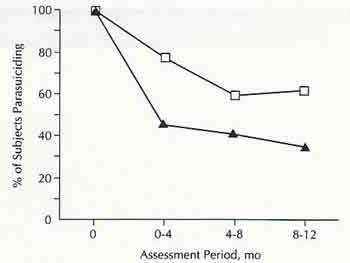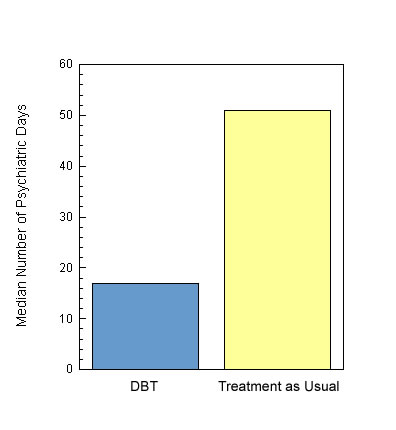Windows to Research: Testing a Therapy for Borderline Personality Disorder
Adapted from Linehan, M. M., Armstrong, H. E., Suarez,
A., Allmon, D., & Heard, H. L. (1991). Cognitive-behavioral treatment of
chronically parasuicidal borderline patients. Archives of General Psychiatry,
48(12), 1060-1064.
|
|
Individuals who meet criteria for borderline personality disorder (BPD) are widely recognized by therapists as difficult to treat. Diagnostic criteria for the disorder include repeated suicidal behavior or self-mutilation, intense anger, and unstable interpersonal relationships (click here for a full listing of criteria). Many of these behavioral patterns complicate treatment, and few treatments have demonstrated efficacy in improving the behavioral patterns of these individuals.
|
|
|
The research described here represents the first appearance in the literature of an empirical test of cognitive-behavioral therapy for BPD. This therapy, termed Dialectical Behavior Therapy (DBT), balances acceptance of the client with encouraging behavior change. The therapy is grounded in the technology of behavior modification, but also draws upon other approaches, including eastern philosophy and mindfulness practice. In order to test the efficacy of DBT, a randomized controlled study was conducted in which participants were assigned to either (1) Dialectical Behavior Therapy or (2) treatment as usual in the community. Treatment as usual refers to the participants being able to choose from among a list of referrals provided to them, or to choose to not seek treatment.
|
|
|
Participants were referred to the study through clinical contacts in the community. Researchers screened potential participants to be certain they were appropriate candidates for the study. For example, participants needed to score at least 7 out of 10 on the Diagnostic Interview for Borderline Personality Disorder and they needed to meet DSM-III criteria for Borderline Personality Disorder (participants with schizophrenia, substance dependence, bipolar disorder, or mental retardation were excluded from the study). Participants were women between 18 and 45 years old. The participants signed consent forms and agreed to be randomly assigned to one of the two conditions and to drop out of other individual psychotherapy if they were assigned to Dialectical Behavior Therapy. There were a total of 22 participants in each of the two conditions in the study.
|
|
|
Treatment lasted for one year, and assessments were conducted at the beginning of treatment and every 4 months thereafter (i.e., there was a pre-treatment assessment, as well as one at 4, 8, and 12 months). The assessments focused on parasuicidal behavior, utilization of psychiatric services, and participation in treatment.
|
|
|
Analyses involving the comparison of proportions or percentages used the z-test for proportions and analyses involving the comparison of group medians used the Mann-Whitney U-Test. The non-parametric test comparing medians was selected because the data indicated the likelihood of the violation of distributional assumptions necessary to carry out valid parametric tests comparing group means.
|
|
|
Participants receiving DBT were significantly more likely to
maintain therapy with the same therapist for the entire year than were
participants in the treatment as usual condition (83.3% vs. 42.0%,
respectively, z = 3.59, p < .001).
Parasuicidal behavior was also significantly less in the DBT group
than in the treatment as usual group; although 100% of participants in both
conditions engaged in parasuicide prior to treatment, participants receiving
DBT had substantially less parasuicidal behavior at the 4, 8, and 12 month
assessment points (z = 2.36, p < .01, 1 tailed; z = 1.62, p < .05, 1
tailed; z = 1.98, p < .05, 1 tailed, respectively; See Figure 1). |

|
|
Figure 1. Percentage of
subjects with parasuicide, by condition.
Triangles represent participants receiving DBT and squares represent
participants receiving treatment as usual. |
|
|
The two treatment groups also differed in the median number of
days of psychiatric hospitalization (z = 1.70, p < .05). See Figure 2 for
these results. |

|
|
Figure 2. Comparison of
median number of psychiatric days for control and DBT groups. |
|
|
The researchers concluded that the study demonstrated the effectiveness of Dialectical Behavioral Therapy for women who are chronically parasuicidal. In the Letters to the
Editor section of the Archives of General Psychiatry (volume 50,
February 1993), Ralph Hoffman of the Yale Psychiatric Institute wrote:
Dr. Hoffman was concerned specifically with two questions: (1) whether participants in the DBT condition got free or reduced rate therapy as opposed to participants in the "treatment as usual" control condition who might have had to pay higher fees. and (2) whether the control condition therapies were quantitatively less than the DBT therapy. Dr. Linehan responded to both of these concerns. To the first, she stated, "Did patients pay for DBT? No. Can we attribute the superior retention rate of DBT (83.6% v.s 50%) to this fact? We cannot summarily rule out thisinterpretation. We could not, however, find any discernible difference in cost of therapy of payment method between [control] subjects remaining in therapy and those who dropped out." To the second issue, Dr. Linehan responded, "Is the superiority of DBT due to quantitatively more hours of theraputic availablity in DBT? Our data indicate otherwise." Dr. Linehan went on to provide statistical support for the claim that clinical outcome is not reliably predicted by the total number of therapy hours, and that even by statistically controlling for differences in the number of hours of therapy, DBT was still superior to the treatment as usual control group. |
|
|
Questions
|
|
|
1. What type of experiment did the researchers conduct ? 2. What is the independent variable in this study ? The dependent variables ? 3. Researchers might attract more volunteers to participate in a yearlong experiment like this one if they allowed participants to select their own condition. Why not compare simply compare the results for women who wish to enter Dialectical Behavioral Therapy with women already taking part in some other type of therapy ? 4. Attrition can be a serious problem in yearlong experiments that test new therapies. Here attrition was lower than usual and did not vary across the two conditions. Suppose, however, that 20 of 22 participants randomly assigned to community treatment as usual finished the experiment but only 12 of 22 participants assigned to Dialectical Behavioral Therapy finished the experiment. How could this pattern of attrition influence the interpretation of the results? 5. Can the results of this study be generalized to ALL chronically parasuicidal people who meet criteria for borderline personality disorder?
|
|
|
Individuals
with a University of Washington NETID may wish to read a recent research
article that follows up this experiment and is available on line. See Bohus, M.,
Haaf B., Stiglmayr, C., Bohme R., & Linehan, M. (2000). Evaluation of inpatient
dialectical-behavioral therapy for borderline personality disorder--a
prospective study. Behaviour
Research and Therapy, 38(9), 875-887. |